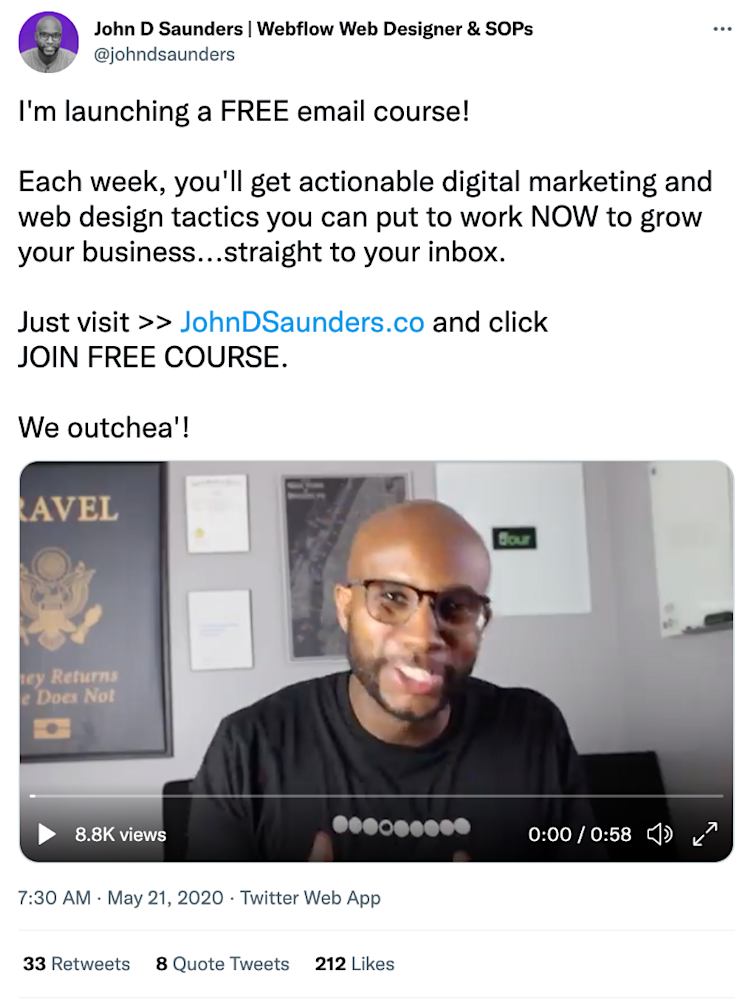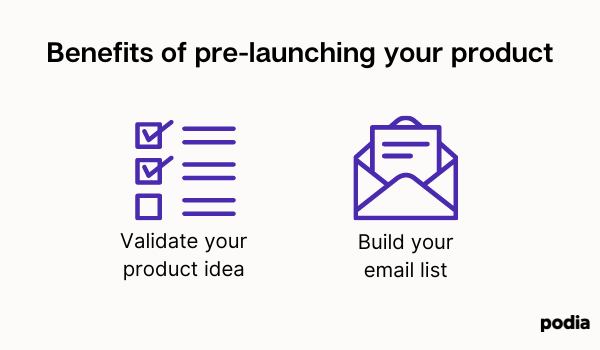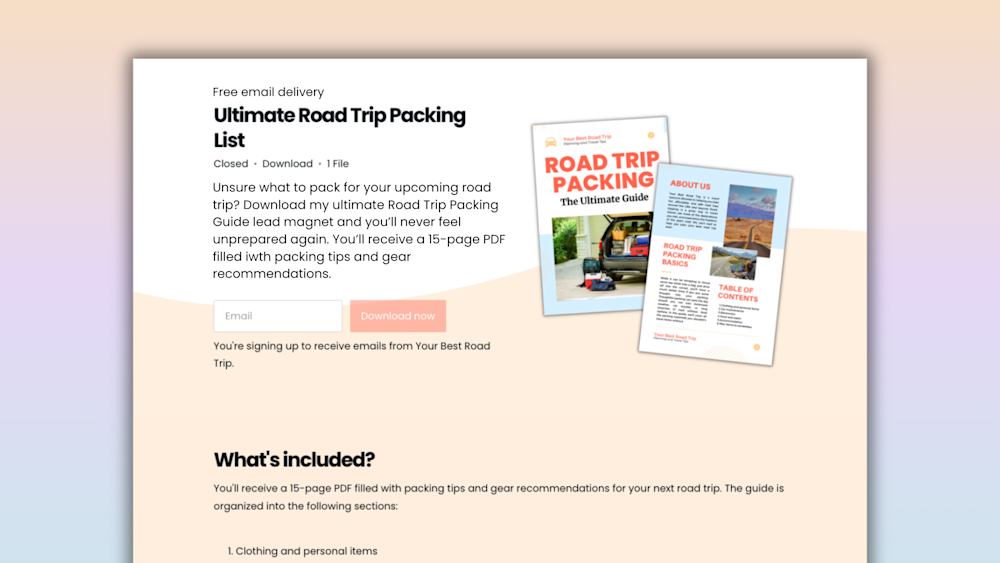A wise person once said, “By failing to prepare, you are preparing to fail.”
When it comes to launching a new digital product, we couldn’t agree more.
After hours of brainstorming, research, and hard work, you’re finally ready to launch and sell your digital product. The last thing you want is a disappointing launch day.
That’s where planning ahead comes into play. A solid product marketing plan can mean the difference between a $10,000 launch day and a failed product launch. And you don’t have to be a marketing pro to create that plan.
To help you get set up for success, we put together a six-point checklist for building your marketing plan. Follow these steps to create a marketing roadmap you can use for every new product launch.
Product launch marketing plan checklist

Download a PDF of the checklist here.
Step 1: Set goals for your product launch
You can have the biggest marketing budget and the fanciest tools, but until you set goals, your marketing plan is like a ship without a rudder: directionless.
Marketers tend to have a bad habit of setting vague goals. We say things like “make more sales” and “drive engagement” without really digging into what meeting those goals looks like in action.
Why do we do that? For one thing, it’s hard to recommend specific universal marketing goals or ways to measure success. Every creator has different key performance indicators (KPIs) depending on their goals.
Setting goals that are specific to your business, brand, and product can help you select which metrics to track leading up to your launch.
For example, if your goal is to collect pre-launch signups for your new online course, you might track the number of website visitors who sign up for your pre-launch email updates.
On the other hand, if your goal is to convert new customers through social media ads, you would track how many people click on your Facebook ads, and how many of those visitors then purchase your product.
To set the right goals for your marketing plan, we recommend the SMART goal framework.

With the SMART goal framework, you design your goals to meet five criteria:
-
Specific: Set detailed goals that narrow in on a particular part of your business.
-
Measurable: Make sure that you can quantify your goal and track your progress.
-
Attainable: It’s fun to dream big, but pie-in-the-sky goals can quickly become discouraging. Keep your goal challenging but achievable.
-
Relevant: Check that your goal aligns with your values, brand, and overall business goals.
-
Time-bound: Give yourself a realistic deadline to achieve your goal. Deadlines hold us accountable and give us a timeline to work towards.
For example, say you’re a month out from launch day for your new online course. You want to validate your product idea and grow your email list by gathering pre-launch signups.
Your SMART goal might be: “By adding a pre-launch landing page to my website, I will collect 100 pre-launch email signups before launch day next month.”
With specific metrics in mind, a realistic goal, and an action plan to get there, you can set yourself up for a successful launch. What that action plan looks like depends on a variety of factors — including your audience.
Step 2: Define your target audience
One of the most important questions to ask before starting a new business is, “Who is my target market?”
That question is just as valuable when planning for the launch of a new product.
Here’s why: You can’t market your product if you don’t know who you’re marketing to.
Your target audience is the group of potential customers you plan to sell your products or services to. To make your marketing as effective as possible, you need to get to know your potential customers as people, not just demographics.
That’s where buyer personas come in.
Content marketing consultant Amy Wright explains: “Buyer personas describe who your ideal customers are, what their days are like, the challenges they face, and how they make decisions.”
A buyer persona might look like this example of one of Spotify’s target customers:

To build your buyer persona, it’s time to do some customer research and discover what your audience wants to learn, achieve, and buy.
Look at forums, online communities, and reviews for products in your niche. Ask yourself:
-
What are my target customers talking about online?
-
What challenges do they face?
-
What are their goals?
-
What do they value?
-
What language do they use?
When you learn how your audience talks and thinks, you can better communicate why your new product is a great fit for them.
If you have an online community of your own, don’t be afraid to ask them directly what they’re looking for. Reach out to your brand community, email list, and social media followers and ask them to share their feedback.
Your audience wants to share their feedback and ideas with you. 64% of consumers want brands to connect with them, and 90% of consumers have a more favorable view of businesses that ask them for feedback.

When you create discussions in your brand community, you can build connections and bond over shared values. You get to know your target audience more personally, which helps you create marketing messaging that resonates with them.
You can even ask your existing customers to test out and share feedback on a prototype of your new product.
One great example of learning from your customers comes from Tiffany Williams, founder of CEO InsideHER.

Tiffany learned what her audience valued by asking them directly. “I just ask my audience what they want, what they want to learn, and if it matches something that I have done, and I have been successful with, then I teach it to them,” Tiffany shared with us.
Getting to know her customers helped Tiffany build a membership community of nearly 40K entrepreneurs and sell digital products that help her audience grow their own businesses.
(Podia makes it easy for creators like Tiffany to connect with their audience and sell digital products, all from one platform. Give Podia a try today with a free 30-day trial.)
Overall, the better you get to know your target audience, the more you can tailor your marketing to fit their needs and show them how your product can help them succeed. You’ll need that info in this next step.
Step 3: Establish your unique selling proposition (USP)
Once you know all about your target audience’s pain points, needs, and goals, you can define your unique selling proposition (USP).
Start with the result you want to offer your customer, then work backward to determine how your product achieves that result. That’s your USP.
Your USP, also called your value proposition, answers two questions:
-
What problem does my product solve for my customers?
-
What makes my product different from my competitors?

When you define your USP, you’re reaffirming that your product helps your audience meet their goals or overcome a real obstacle. And that’s a key piece of a successful product launch. 35% of startups fail because there’s no market need for their products or services.
In other words, there’s no product-market fit. Your product-market fit is how well your product meets customer demand. Your USP pinpoints that product-market fit and explains what sets you apart from the competition and makes potential customers choose you.
If you aren’t sure what makes your product stand out, conduct market research to learn more about your competitors.
Are there any pain points your competitors don’t address? What does your product do differently? You might have a course with more visual lessons than others on the same topic, or maybe your experience gives you a different perspective from other creators in your niche.
Your USP also helps you figure out how to market your product.
Take Death Wish Coffee, for example. Most coffee brands highlight features like smoothness or flavor, but Death Wish takes a unique approach, claiming to be “the world’s strongest coffee”.

Death Wish knows that their ideal customer wants extra-strong, kick-in-the-pants coffee, so their marketing messaging highlights that differentiator. Their USP might not appeal to every coffee drinker, but it showcases what makes them unique and is tailored to their target market.
All in all, when you know what makes your product special, you can highlight that in your messaging. Use the same language that your target audience uses when talking about their pain points. Your messaging will resonate with the right customers.
You’re nearly ready to share that messaging with the world — but first, let’s make sure you can do it without breaking the bank.
Step 4: Determine your marketing budget
As a creator, you probably don’t have the budget to hire an outbound sales team and in-house marketing staff, and that’s okay. But you need to figure out how much you can afford to spend on marketing before you start running ads or commissioning designs.
How much money you set aside for marketing depends on your overall budget, product launch goals, and how many tasks you outsource vs. handle in-house.
The good news is that you don’t need a six-figure marketing budget to execute a successful strategy. In fact, more than one-third of small businesses spend less than $10,000 on advertising each year.

As you figure out your budget, you may want to allocate money to costs like:
-
Software and tools to create content, communicate with your audience, and manage campaigns.
-
Freelancers, like graphic designers, copywriters, video editors, and web designers.
-
Paid advertising, such as sponsored content, paid search ads, and social media ads. (We’ll talk more about paid social ads in the next section.)
If you can’t afford to hire freelancers or buy high-end software, don’t worry. You can still create a high-quality marketing campaign on a budget. Here are some resources that can help:
With your budget in hand, you’re ready to move on to step five and pick the right marketing platforms for your product launch.
Step 5: Choose your marketing channels
As you’ve hopefully realized by now, there’s no one-size-fits-all way to promote a new product.
Different tactics resonate with different audiences, and not every platform will work for every creator, budget, and product.
Plus, there are more digital marketing channels out there than any one creator could tackle on their own, so it’s essential to find the right ones for you and your customers.

Here are a few of the most popular channels to consider including in your marketing plan.
Email marketing
Email marketing is a must-have in any digital marketing strategy. Over 4 billion people will use email this year, collectively sending about 320 billion emails per day.
Marketers and customers alike love email. 73% of consumers rank email as their top channel for marketing messages, and 59% of marketers cited email as their top source of ROI in 2018.
Email is also an affordable option for small businesses with a tight marketing budget. At around $42 for every $1 spent, email has one of the highest returns on investment (ROI) of any marketing channel.

To use email marketing in your product launch campaign, you need two things: an email list and an email marketing platform.
One way to encourage potential customers to sign up for your email list is via lead magnets. A lead magnet is a high-quality resource, like a free digital download, that users receive in exchange for their email address.
Here are some resources to help you grow your email list, choose an email platform, and make the most of your email marketing:
-
Create your first lead magnet in 90 minutes or less (+5 ideas)
-
14 digital marketing email templates for every awareness level
Social media marketing
59% of Gen Z and 55% of millennials discover products on social media, so it’s no surprise that many creators and entrepreneurs use social media to sell digital products.

You can find the best social media platforms for your small business by figuring out where your customer base already spends their time online. Then, decide if you’ll use organic vs. paid social media advertising.
Social media marketing works best when you combine organic and paid initiatives. Organic social media marketing lets you engage with your community and potential customers, while paid social ads help you get more eyes on your products.
To build some buzz around your new product, Twitter is a solid choice. For example, designer and marketing expert John D Saunders used a video on Twitter to announce a new online course:

John’s video let his audience know what to expect from the course and saw high engagement with 30+ retweets and over 200 likes.
Engaging his audience on Twitter and beyond also helped John earn $10,000 on launch day and $100,000 overall from his first course on Podia.
On the paid social side, ultra-specific targeting tools help you reach more of the right people faster than organic can. Over 62% of marketers say that paid social media advertising has been at least somewhat effective for their business.
Facebook ads are an affordable choice for small businesses and solopreneurs to get their new products in front of a larger audience. For example, business coach Melyssa Griffin used this video ad to promote her Pinterest workshop for bloggers.

With the right audience targeting in place, Facebook ads like Melyssa’s translate to digital product sales for creators.
Here is an additional resource to help you master social media marketing:
Content marketing
Content marketing costs 62% less and can generate more than three times as many leads as traditional marketing. It’s an affordable way to reach your audience, establish your expertise, and build relationships with prospective customers.

80% of people read, watched, or listened to a piece of content from a brand in the last year. That content can include videos, visual content like infographics, live and pre-recorded webinars, and, of course, blog articles.
Here’s how starting a blog can play a big role in a successful product launch:
-
Your ideal customers discover your blog content through search or other distribution channels.
-
They learn from your articles and begin to trust your expertise.
-
They sign up for your email list or follow you on social media.
-
You keep them updated about your product launch.
-
They’re excited to buy your new product, support you, and continue to learn from you.
The key here is to create blog posts that provide real value, not just longform product ad copy.
For example, if you’re selling an online course on dog training, you could write a blog post about high-value vs. low-value treats to reward your dog. Your followers will come to trust your dog training expertise, making them more likely to buy your course as soon as it launches.
Make sure to write your blog content with search engine optimization (SEO) in mind. SEO makes it easier for your target audience to find you when searching for relevant keywords and phrases. That’s why nearly 64% of marketers actively invest time in SEO.

Here are some resources to help you get started with SEO and content marketing:
-
A step-by-step guide to SEO for selling digital products
-
Simple SEO tips that require no technical skills
-
How to give away free content and make more sales in 3 steps
Website and landing pages
Picture this: Your launch marketing is all going according to plan.
Potential customers are flocking to your website, ready to learn more about your product, sign up for pre-launch updates, and eventually make a purchase. Now, you need a landing page that makes all your hard work pay off.
Before your product goes live, you can create a pre-launch landing page. Pre-launching your product has two big benefits:
-
Validating your product ideas.
-
Building your email list leading up to your product launch.

On your pre-launch landing page, include a short description of your new product and tell visitors why they should sign up to learn more and get notified when you launch.
Come launch day, that pre-launch page becomes a product page that, with the right copy, turns visitors into buyers. You don’t have to be a professional copywriter to craft a sales page that converts. You just need to help your potential customers answer, “Is this for me?”
To answer that question as you write your sales copy, go back to the USP you established in step three. Focus on your product’s benefits rather than its features. A feature is a part of your product, while a benefit is the impact that feature has on your customer.
Take a look at Nicole Saidy’s product description for her online course, Become a UI/UX Designer.

Nicole understands that transitioning to user experience design can be overwhelming — but she’s here to help. She helps her audience determine if the product is right for them by speaking directly to their pain points.
Here is a resource on crafting landing and product pages that bring in sales:
With your marketing channels chosen, you may think you’ve reached the end of the checklist. But there’s one more vital step to make the most of your product launch marketing and set yourself up for success — now and for many product launches to come.
Step 6: Track your results and keep iterating
Our sixth and final step, tracking your results and iterating on your marketing, is more of an ongoing process than a checklist task.
During and after your product launch, revisit the goals you set in step one. If you’re not meeting your goals, you have an opportunity to learn and make changes for next time or even update your current marketing activities.
For example, let’s say your email marketing campaigns aren’t performing as well as you expected. Your open and click-through rates are lower than you’d like them to be, but you still have time to make changes before launch day. It may be time to run some A/B tests.

A/B testing (or split testing) involves changing different elements of your email one at a time, then seeing how those changes affect your performance.
If you were A/B testing different subject lines, for instance, your subscribers would receive identical emails except for the subject line. By comparing the two open rates, you can see which subject line performs better, then use that knowledge in future email campaigns.
Above all else, remember that trying new things and allowing yourself to make and learn from mistakes helps you grow as a creator.
Maybe you discover that a certain marketing channel isn’t the right fit for your business or audience. That’s valuable information to bring into your next product launch plan.
In fact, Python developer and successful course instructor Reuven Lerner recommends experimenting with different marketing channels to find what works best for you.
“Experiment! It’s hard to know how to market online, and every group of potential customers is a bit different. So you’ll have to experiment to find out what’s effective (and what isn’t). With everything you do, consider, measure, and then modify your techniques to improve them. There’s no one magic bullet here!”

It can feel discouraging to discover that your marketing efforts aren’t getting results but embracing the experiments that don’t work out is a major part of succeeding in business. Ryan Kulp, founder of Micro Acquisitions, explains:
“To run a successful business, you have to first get comfortable running an unsuccessful business, because most of the time, success comes later.”
In the Startup Curve, coined by Y Combinator founder Paul Graham, failure is a standard phase that happens right before your business starts heading upward toward scaling and growth.

Business coach Minessa Konecky agrees. “I think that what we really need to do is look upon past failures and mistakes as wells of information that we can then use to feed whatever it is that we’re doing now.”
Bottom line:
Don’t be afraid to experiment with your marketing to find what works best for you, your brand, and your audience. With your goals in mind and a little patience, you’ll be well on your way to an effective launch strategy that you can use for many product launches to come.
Craft a go-to-market plan for launch day success
You’ve worked hard to create a product your audience will love. A successful marketing plan can help all that hard work pay off come launch day.
To recap, here are the six steps to create a marketing plan for your product launch:
-
Set SMART goals for your product launch. Figure out what a successful launch means to you and which metrics you’ll track.
-
Define your target audience and get to know them as people, not just demographics. Conduct customer research and talk to them to learn more about their challenges and goals.
-
Establish your unique selling proposition (USP). What makes your product the best choice for your ideal customer? How do you stand out from the competition?
-
Determine your marketing budget. You don’t need to spend an arm and a leg to create a marketing campaign that drives sales.
-
Pick your marketing channels. Email marketing is a must-have, but there are a variety of other platforms out there to choose from. Figure out which ones align with your audience and goals.
-
Track your results and keep iterating on your marketing strategy. The more you learn about your customers, the more successful your next product launch marketing plan will be.
Remember, you probably won’t get it 100% right the first time, and that’s okay. It may take some trial and error, but once you figure out what works for you and your customers, you’ll be a product marketing pro with the launch day sales to prove it.



